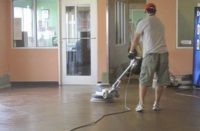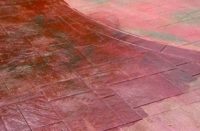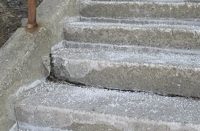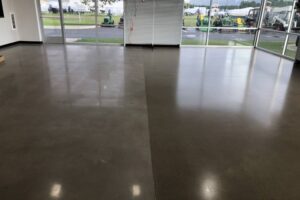
Consumers, often blown away with the low prices of desktop inkjet printers, forget to consider the additional cost of ink cartridges which put many of them on a first name basis with the folks at the office supply store.
If you’re selling decorative concrete as no-maintenance, you could be missing out on tapping into the same sort of profit center those cartridges represent, either through selling products or providing maintenance services — or both.
And, you’ll greatly decrease the likelihood of clients bad-mouthing you to friends and neighbors months or years after you’ve forgotten that “no-maintenance” job.
Not No-Maintenance
Certainly larger commercial and retail jobs offer their own challenges. However, they also offer a couple layers of protection for the average contractor called in to install concrete, whether it’s a polished floor, stamped sidewalk — or even a sports stadium.
First off, it’s rare for a job of that type where a sealer or guard isn’t part of the specifications, says Christopher Pfeiffer, owner of Concrete Sealers USA.
“Sealers are required and the contractors don’t have any choice,” he says. “They have to seal. On the residential side, sealing isn’t as far along.”
The other thing, says Mike Price, owner of Bay Area Concretes Inc. in Livermore, California, is that those very public spaces are generally maintained by someone hired specifically for that purpose and — in theory— trained for the job. Of course, it’s not foolproof.
“Sometimes, they may have stripped the sealers off over time in the course of normal maintenance,” he says. “And, universities and airports are notorious for maintenance crews coming in with a wax and building up a layered wax surface, which isn’t needed at all and can actually trap dirt.”
On the homefront, however, the care needs of a concrete surface are a bit smaller, partly due to size, and partly due to the amount of wear and tear it’s likely to receive.
Kevin Sigourney, Consolideck product manager for Prosoco Inc., says, generally speaking, a residential floor shouldn’t need to be resealed very often.
“Obviously, there’s a big variety of sealers out there; the sealer category is quite broad,” he says. “However, most of the types of sealers that we’re finding being used on polished concrete are in homeowner residential-type situations, and you’re probably looking at three-to-five years of service life.”

That’s assuming normal wear and tear, which Darryl Manuel, president of Vexcon Chemicals, says is pretty much the universal reason why homeowners can become unhappy with their concrete installations.
However, Manuel says, unhappiness can stem from a whole laundry list of potential problems, from yellowing, flaking and blistering to issues such as lack of resistance to deicing chemicals, petroleum products or pool chemicals, depending on location.
Beyond those garage and pool issues, though, Price says many of the complaints he hears from homeowners are similar to what he gets from larger food service operations.
“For homeowners, it’s things like olive and vegetable oils or grease — like bacon grease — that pops out of the pan and lands on the floor,” Price says. “If they don’t clean it up, over time it acts like a solvent, so it penetrates the concrete and leaves a spot. There are also spills like barbecue sauce, tomato juice and other things with an acidic base. If they sit on the floor, it will slowly etch the surface.”
Education time
Peter Wagner, the director of supporting products development for Curecrete Distribution, agrees that when interior residential maintenance is discussed, the overall situation is most akin to talking about restaurant maintenance.
“You’re going to be introducing foods and things that will spill and stain,” Wagner says. “Despite what the homeowner says, it’s unlikely they’re going to be able to isolate things to a point where they only eat in one location or put coasters under everything.”
There are also other situations where protection is needed. For instance, some spilled liquids can take out a color, while others can change it. Even lack of UV filtering through windows can fade dyes on a floor.
“Sure, in many ways a concrete floor will be easier to maintain, but you also have to address preventive issues,” Wagner says.
The causes may be different, but the potential for damage is often even greater with concrete outdoors or in the family garage, says Concrete Sealers’ Pfeiffer.
“A lot of people are surprised by the problems they can have with their new cementitious surface, whether it’s in a garage or a driveway,” he says. “Especially in northern and Midwestern climates, you’re dragging in snow and slush and salt and you can get cracking, pitting and spalling.”
Other climates don’t mean driveway or garage concrete is home free, either. It’s highly likely they’ll soon be hit with dripping gasoline, motor oil or other lubricants, or fall victim to hobbies that include painting or welding.
The best thing a contractor can do is to educate potential clients about maintenance before the contract is even signed.
“We spend an awful lot of our time educating people on maintenance, and making sure that people understand it’s not a no-maintenance floor,” says Prosoco’s Sigourney. “There’s no such thing as a no-maintenance floor. It’s a low-maintenance floor and there’s a right way and a wrong way to maintain it, as there is with any surface.”

The downside to that, Curecrete’s Wagner acknowledges, is, “You might educate the person to the point where they go, ‘This scares me; I’m not going to do it, but thanks for your time.’”
However, he says that’s probably better than having an unhappy client later on down the road or fighting to have your invoice paid in a timely manner, or at all.
Food for thought
Talking to the client before any concrete is poured is definitely the best way to get the job off on the right foot, then doing the best job possible will go a long way toward keeping maintenance at bay for the client.
“Think about the quality control that goes in when you start a polished concrete project,” says Bay Area’s Price. “You want to properly polish the concrete, and use the proper densification system and the proper honing, going up through the different steps of diamond grits to get a good, hardened, honed polished surface that’s going to be more dense and more difficult for stains to penetrate.”
It’s then you can think about which sealer or guard is best for that particular job, based on porosity of the concrete, whether it’s colored and with what, and its exposure to everything from grit and salt to food, gasoline and moisture.
Just as with larger jobs, the best time to apply a cure and seal is soon after the pour. Vexcon’s Manuel advises doing the work when all the bleed water has been absorbed and the contractor can walk on it.
“It should be kept damp with water spray until that time,” he says. “The procedure will provide a concrete surface that’s properly hydrated, which will prevent spider and micro-cracking and provide a harder wear-resistant surface. Of course, the temperature at application is important.”
What happens after that mainly rests in the client’s hands, but contractors can play an important role which can bring extra money to the table.
While Prosoco’s Sigourney says many homeowners are now more savvy about the products they’re using on their concrete surfaces thanks to the internet, Curecrete’s Wagner advises contractors to give homeowners a sample of a cleaner specifically formulated for their type of decorative concrete.
Wagner also advises not falling into the common trap of a cleaner needing to be a neutral pH. He says it just needs to be in the 9.5. range. Ideally, you might even bid the job a little higher to cover the time to actively demonstrate to the homeowners how to maintain their new concrete, he adds.
Another option, says Bay Area’s Price, is to give each client written information on the new surface.
“We provide our clients with a binder that has a maintenance care section in it,” he says. “We tell them what we’ve used on the floor, how to maintain it and what chemicals we recommend they use. We also tell them to call us if they have any questions.”
He adds that the information can be invaluable not only to the homeowner, but saves research if the maintenance arm of his company or another is called in to repair and rejuvenate a surface in the future.
“I predict in the next five to 10 years, many companies will add a maintenance division,” Price says. “It just makes sense both as a revenue source and as a quality control stream.”
Sealed with a guarantee
by Stacey Enesey Klemenc
When it comes to maintenance, Michael Fennessy, owner of Stampcrete International, a company in Liverpool, New York, he founded in 1984, is dead focused on sealers.
For over a decade, he heard complaints from homeowners and contractors concerning sealers that would yellow and amber and just plain not hold up over time. So about three years ago, he got so tired of the constant bellyaching that he searched the world over before hiring a chemist that was up to the task of developing what could be called the ultimate sealer.
“But it came at a price”, Fennessy says, of his Ultra Sheen line. He says he buys most of his chemicals from Dow Chemical Co., a global leader in innovation and sustainability that boasts of thousands of patents and awards. “The products in the line cost about double than what we were charging before,” because it costs him a lot more to produce. But, he notes, you get what you pay for: If you want a Mercedes, you’re not going to get it for the price of a Ford.
“As crazy as it sounds, the new sealer is going out the door as fast as we can make it,” he says. It was just introduced earlier this year.
To help distribute the Ultra Sheen sealer line, among other products, Fennessy founded a new company, The Sealer Depot, in 2016. In April, he launched eight new sealers, including one with a true matte finish, another a water-based pigmented formula and three formulated especially to meet the VOC limits for the EPA’s defined Architectural and Industrial Maintenance (AIM) coating categories, under which many of the states in the Northeast must abide by.
Although the solvent based-sealers are still big sellers, he notes, “We’ve sold more water-based sealer in the last 50 days than we did in the last five years.”
He credits the new products’ success on a number of things besides a wide selection of sealers for both interior and exterior applications. Ultra Sheen comes in 3-gallon, 5-gallon and 55-gallon drums to suit a variety of project sizes. And, Fennessy says, “If the sealer ever yellows, we’ll give you your money back.”
www.thesealerdepot.com
















